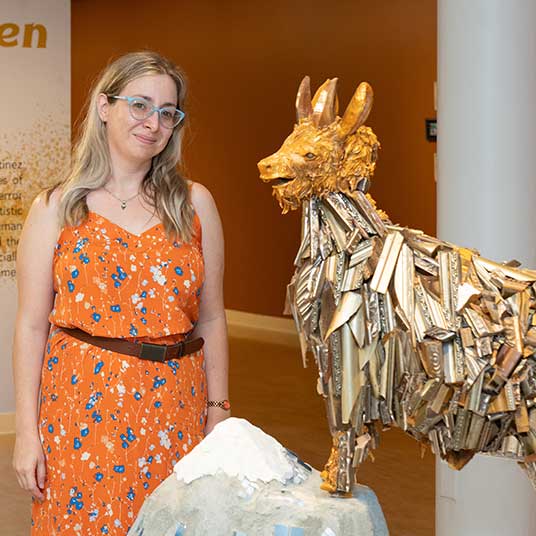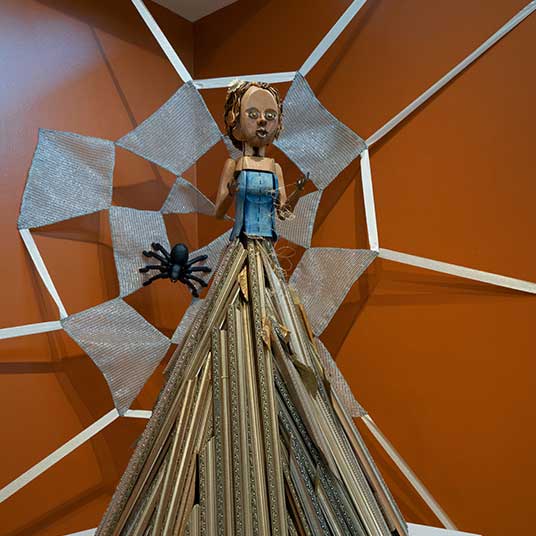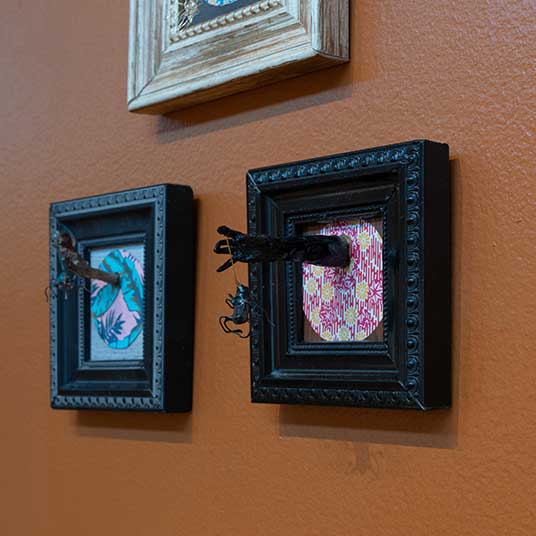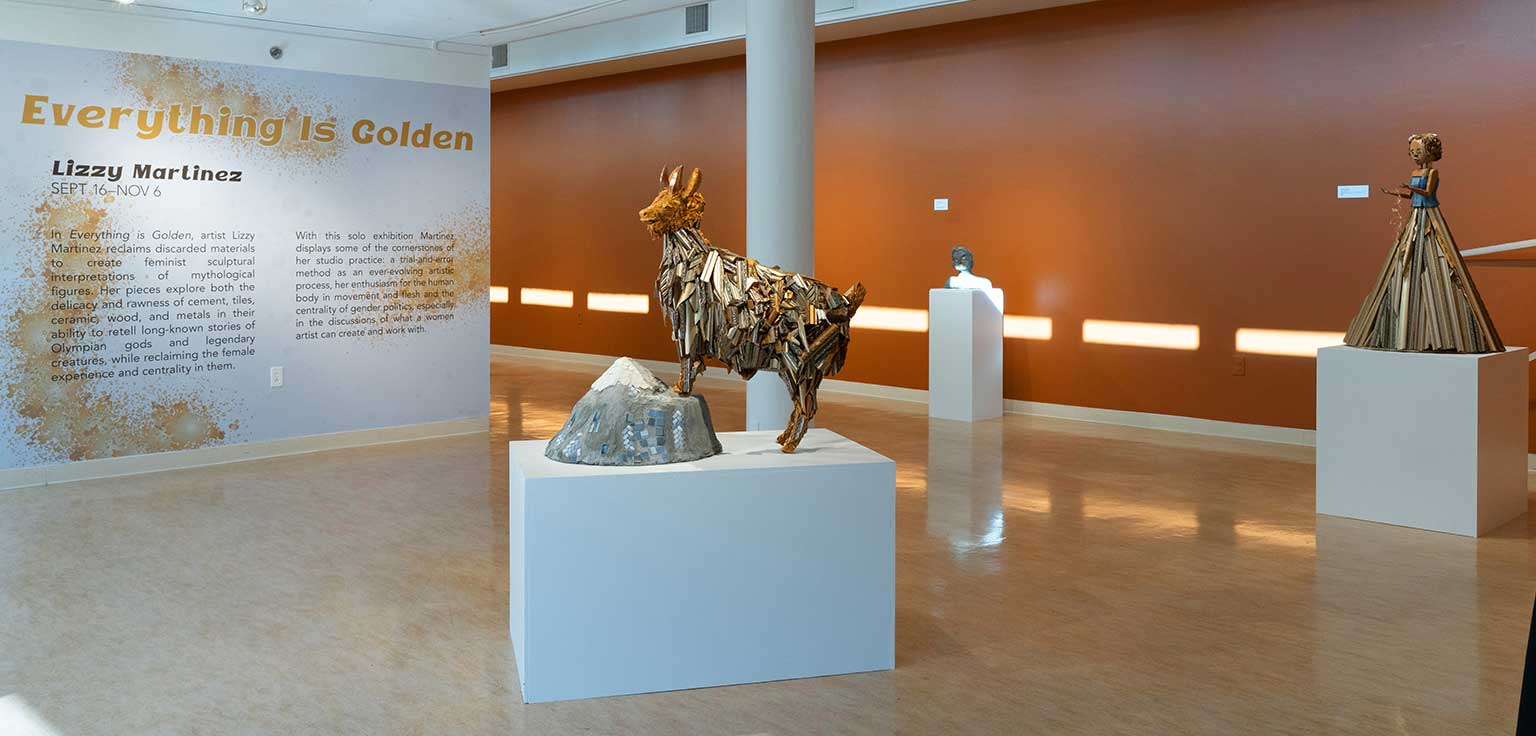My first visit to the studio of artist Lizzy Martinez was not what I expected. Instead of the usual dripping of painting or the row of easels aligned to the walls, Lizzy surprised me with resin molds and hands made of clay on a table. Following her curiosity toward history and mythologies, Lizzy was planning an exhibition with characters of Greek stories, but this time they appear as sculptures made of concrete and discarded materials—reclaimed material as she called them. The planning challenges that came with this approach (how many pedestals, how big they should be) soon left their place for all the educational possibilities I envisioned. There is still, unfortunately, a lot of bodily restrictions and fears around how to behave in a gallery or a museum. However, the pieces invite visitors to get closer, to feel textures and weight with their eyes, all because she already transgressed divisions between trash and objects that deserve care, art that is welcome inside a gallery and the one that is excluded, structures society deem “unfeminine” and the one she wanted to work with.

After the opening of Everything Is Golden, Lizzy talked about her inspiration for this project and the reflections she expects visitors delve on while walking through the exhibition:
When exploring your portfolio, most of your previous work consists in drawings and paintings. What motivated your change to sculpture? Also, you revealed that part of your working method with the exhibition new materials was an exercise of trial and error. Was that something you discovered with this change to sculpture or was it already part of your artistic practice?
Lizzy: The change to sculpture happened on what would be the second year of the pandemic, and it was part of my practice, always sort of experimental, and sort of a side expression. I have worked for decades with wood and occasionally with clay and other mixed materials mediums, but this was just a longer time to play and to allow myself to rediscover and reformulate. I think trial and error exists in drawing, drawing the most challenging things, and drawing in larger format, but I feel like in painting I’m more seasoned and self-assured as that’s my primary medium. In painting, unless there’s trouble, or I’m trying to stretch it with incorporating wax or some of the other weird things that I do that cross material boundaries, usually things just move straight ahead. With this, I’ve never tried concrete before. Even though I’ve done figurative sculpture, this really necessitated the different application of mixing such a heavy material on substrates. I looked at other concrete artists’ recipes, and they all have different ones. I played with those, mixing them; seeing if I liked this person’s ratio and how much I could convert it to freestanding and vertical forms; what kind of substrate could I use in metal and in foam and how thick that could be, and how much weight it could release from the concrete; what kind of results I could get out of discarded materials and how chosen I could make those seem. So, there’s a lot at play with allowing myself to extend the questions and each piece a little bit farther than, say, when I go to sit down or stand at the easel and paint in oil painting. There, the questions don’t exist as much. It was a little bit freeing or a little “starting back” at another level that I haven’t visited for a while. This added a fun way or refreshing element to my practice.

Something that really caught my attention is the fact that this exhibition started in the streets, with you picking up discarded materials from wood shops or construction stores. Do you find a relationship between the use of discarded material and your mythological themes? Once you had the materials, how did you decide to work with these legendary characters?
Lizzy: They elude very well to time. Mythology makes us think about things that are from fallen cultures, discarded, crumbled, and these materials sort of present themselves a little bit easier in that light. They seem like they were excavated in some way from Antiquity. They have that kind of charm to them by being very much made by the human hand. I think that is very befitting using things that were bound for the dump; I’ve given them new life, and elevated them from refuse to art.
For the characters, I’ve sort of exercised two sides of a coin by exploring male side in the form of the satyrs, female side in form of Arachne, and the spiders. And how it pairs with the discarded materials: If we considered ideas of gender, we have to excavate and reformulate what those things are, much like how the art pieces are put together. Ideas of masculinity don’t always withstand in our contemporary culture. There’s a lot of outdated attitudes whether that’s in the workplace or politics or even how we approach development from childhood. Those things have had invisible fences and reductive social mores of gender and how we move through the world. I have a compulsion to reformulate those just as I have feminist ideals that caused me to often reject those mores.
For the female side we have this culture that passes along these stories from Antiquity that reduce women constantly and cast them aside and make them “be aware” tales: if you’re too good people will try and take you down. I think we even have those sorts of stories passed on to us in contemporary culture in a way that I don’t appreciate as a female artist and in a way that I feel the need to rebel against and question through my art. Arachne and a lot of the other female characters of mythology when you look from early or cultures that predate the Greeks, some of those were matriarchies and the female characters didn’t fare as poorly when you actually study the mythologies. As we moved forward through the centuries, patriarchies had political power, religious power, and power within the family structure. Then we saw systematically that the characters of the sirens, the characters of the mortals, and these tales were reduced. They were handed down through our educational system with the compromised version of the female characters. I’m trying to find a way to relieve female characters of that compromise, give female characters back some of their facility, that’s important to me.
Is it important within your artistic vision the dynamic human/animal or human/beast?
Lizzy: I’ve paired animal counterparts with humans in paintings for maybe 15 years. Animals started as sort of serving as a witness within the artistic works: whether it’s octopus spying on the mermaids, and the mermaids are pseudo humans in a way, humans-beast; or if it’s rabbits at a dinner party. Different animals and different human, interactions and social situations. Strange environments, loaded environment, psychological environments. They’re often a proxy for the viewer. They’re in the space with the figures. Somehow, even though they are beasts, they’re easier to withhold any sort of judgment on their behaviors because they’re usually pastoral, or docile, or just hanging out in the spaces in a way that the humans usually are more action-takers. Human figures are easier to judge, and the animals are a calming, reassuring, just pure biological force. I know it might be odd to ask someone to try and bond with a spider, or imagine themselves as a silly goat, but it seems like something I’ve done for a long time, even if it’s not been in sculpture before now.

The name of the exhibition is Everything Is Golden, but your approach with this color is quite subtle in some of the pieces? What does “golden” mean to you? Is it a value? A technique?
Lizzy: Gold is an accent. It’s not the primary substance all the time. I know gold is not an alloy, but it almost seems like an alloy artistically when applied to these different three-dimensional forms. It might be painted on, it might be enameled onto wood or carved out. It might be in the form of bronze, and it’s just more of a shade. Then there’s different shades of gold and sometimes it’s not gold, it’s copper. Tossing it around as sort of this activating force within all the different mixed materials seemed a good tether between them all in some way.
How do you envision the visitor’s experience? What kinds of reflection you would like to generate?
Lizzy: While I was studying abroad in Ireland, I visited a lot of antiquities museums in Naples. That’s where most of the recovered pieces from the dig sites of Pompeii, that were buried within the ash, are displayed. I sort of wished that women had more names associated with the creativity and the output of the pieces. A lot of those things may have come from workshops, that may have had women working as artisans, but their names were lost. In a sense, I have created my own archaeological museum for the gallery, and I want the visitors to feel first a sense of history when they enter the exhibition. If they start to look a little deeper maybe they might pick up reflections on how narrative or how things are changed in time, or the place of women in history and what we understand when thinking on masculinity.
About Karla Aguilar
COCA Curator in Residence
she, her, ella
Karla is a Ph.D. candidate at Washington University in St. Louis. She’s worked as assistant curator for the Hostile Terrain 94 exhibition, as the Museum Education Intern at the Kemper Art Museum and as museum guide at the Pulitzer Art Foundation. She is truly excited to be working at COCA because she cannot separate her thinking of exhibition planning from engagement practices. She looks forward to having COCA students participate in the gallery’s interactive wall, where visitors can have a sensorial experience with the main materials incorporated in the pieces while reflecting on their personal and communal relationship with trash, value, and care. She envisions Everything Is Golden as a safe place for community encounters, so much needed in the continuation of the pandemic, and it is her commitment to invite different St. Louis-based groups to use the gallery’s halls as their places for enjoyment, strategizing, and rest.
